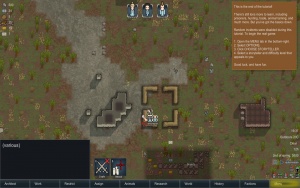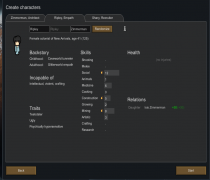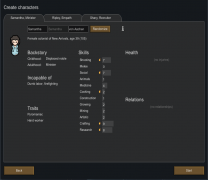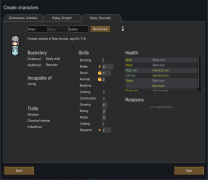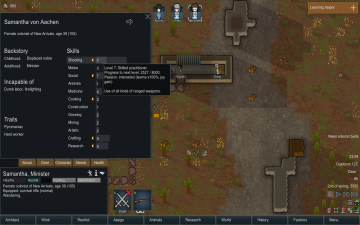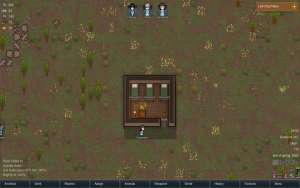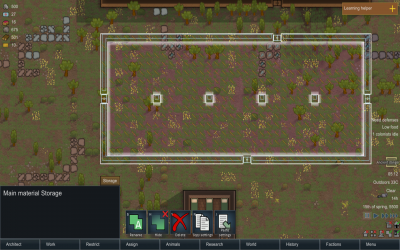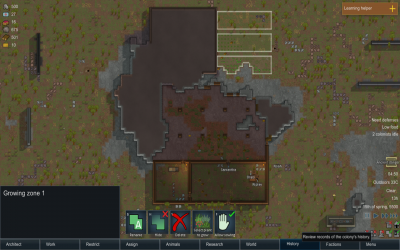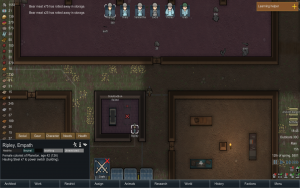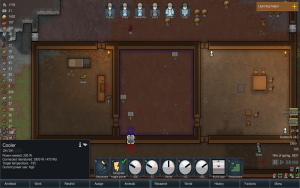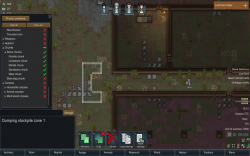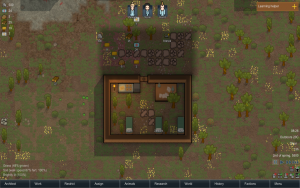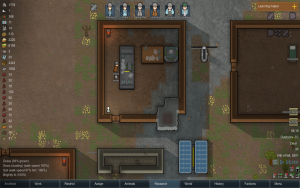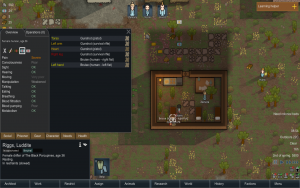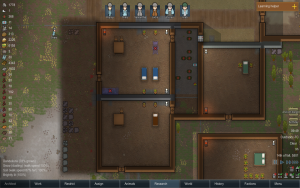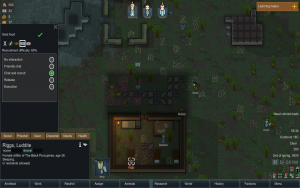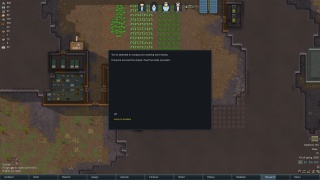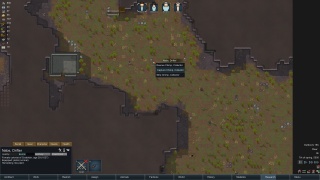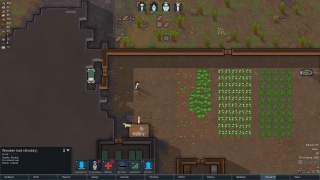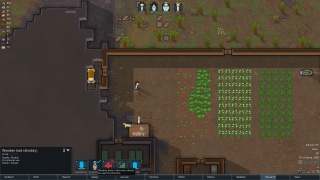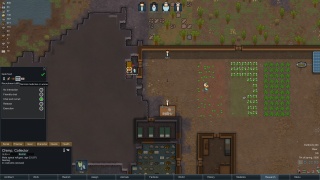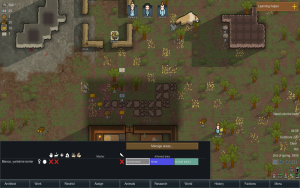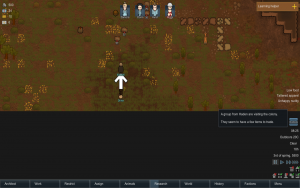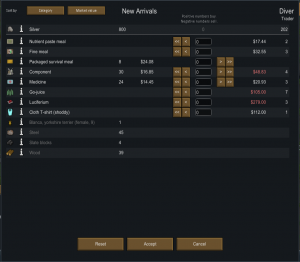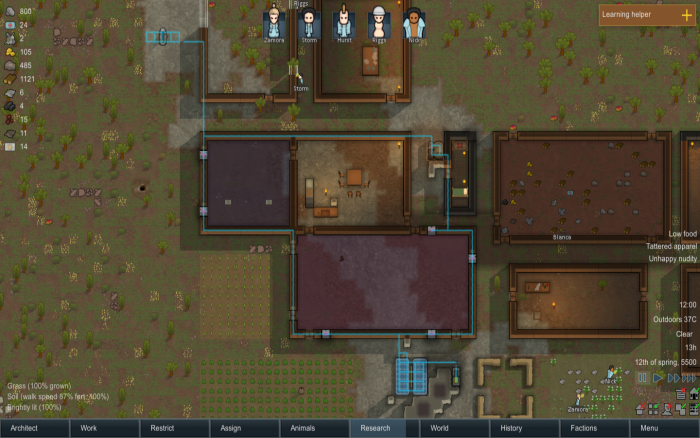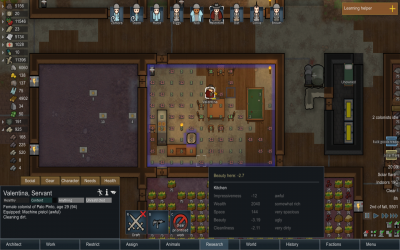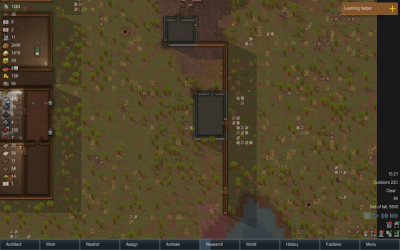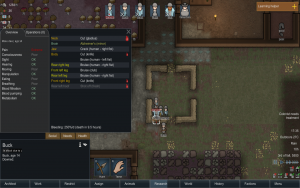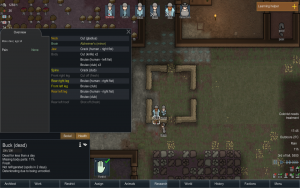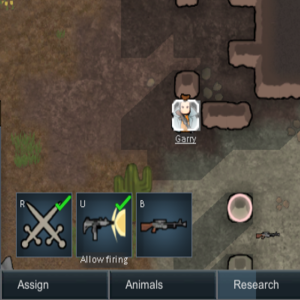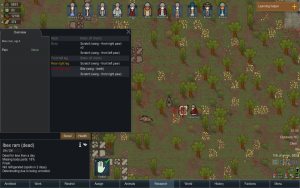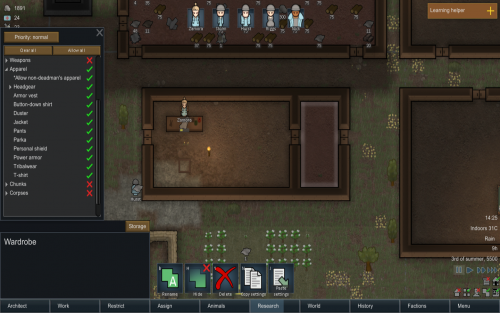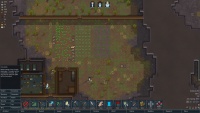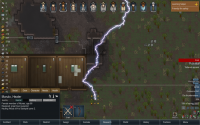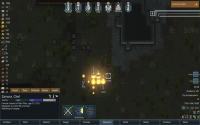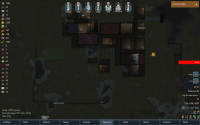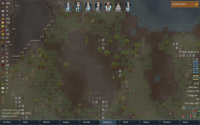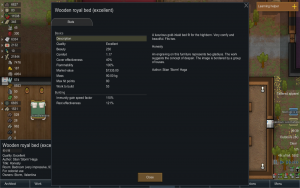Difference between revisions of "Basics"
(→Power) |
m |
||
| Line 9: | Line 9: | ||
This page excludes content addressed elsewhere such as [[Game Creation|game creation]], [[Scenario system]], [[AI Storytellers]], [[World generation]] and [[Biomes]]. Instead, it focuses on basic concepts like: [[Basics#New colony members|Prisoners]], [[Basics#Hunting|hunting]], [[Basics#Trading|trade]], [[Basics#Animals|animal taming]] and much more. | This page excludes content addressed elsewhere such as [[Game Creation|game creation]], [[Scenario system]], [[AI Storytellers]], [[World generation]] and [[Biomes]]. Instead, it focuses on basic concepts like: [[Basics#New colony members|Prisoners]], [[Basics#Hunting|hunting]], [[Basics#Trading|trade]], [[Basics#Animals|animal taming]] and much more. | ||
| − | It is also assumed that the player has already completed the tutorial which will guide them through the Rimworld UI, help them | + | It is also assumed that the player has already completed the tutorial, which will guide them through the Rimworld UI, help them set up a starter base, and defend against their first raider. Starting with [[Version#Recent Version : Alpha 16|Alpha 16]], players are able to select their Storyteller and continue forward with this game. |
This guide is intended for players that are using the original Crashlanded scenario. This scenario setup is detailed in the New Colony section below. | This guide is intended for players that are using the original Crashlanded scenario. This scenario setup is detailed in the New Colony section below. | ||
| Line 26: | Line 26: | ||
</gallery> | </gallery> | ||
| − | For the first time playing it is strongly suggested that players: | + | For the first time playing, it is strongly suggested that players: |
| − | * Pick the standard 'Crashlanded scenario' since it is what most tutorials/information | + | * Pick the standard 'Crashlanded scenario' since it is what most tutorials/information is geared towards. |
* Select the '''[[Cassandra Classic]]''' or '''[[Phoebe Chillax]]''' [[AI Storytellers|storytellers]] on the Builder or Medium [[AI Storytellers#Difficulty | difficulties]]. | * Select the '''[[Cassandra Classic]]''' or '''[[Phoebe Chillax]]''' [[AI Storytellers|storytellers]] on the Builder or Medium [[AI Storytellers#Difficulty | difficulties]]. | ||
| − | ** Alternatively, one may pick Peaceful but they may lose out on learning how to deal with [[Events#Big Threats | major threats]]. | + | ** Alternatively, one may pick Peaceful, but they may lose out on learning how to deal with [[Events#Big Threats | major threats]]. |
* Pick a landing site by clicking on the generated map. | * Pick a landing site by clicking on the generated map. | ||
| − | **For biomes, choose 'Temperate Forest' or 'Arid Shrubland' | + | **For biomes, choose 'Temperate Forest' or 'Arid Shrubland,' which will allow a comfortable location to learn the game, and food will not be a factor except during events. |
| − | **For climate, choose an area where the growing season is 'Year-round' | + | **For climate, choose an area where the growing season is 'Year-round.' |
| − | **For terrain, choose 'Flat' or 'Small Hills' | + | **For terrain, choose 'Flat' or 'Small Hills,' so there is enough area to expand later on. Large Hills is also a good choice as it gives more plentiful resources. |
== Colonist Selection == | == Colonist Selection == | ||
| Line 49: | Line 49: | ||
*** Chemical interest/fascination will often go on drug binges if drugs are present and accessible to them, even if the drugs are forbidden or outside their allowed area. | *** Chemical interest/fascination will often go on drug binges if drugs are present and accessible to them, even if the drugs are forbidden or outside their allowed area. | ||
*** Volatile colonists can go into mental breaks very easily when their mood is low. | *** Volatile colonists can go into mental breaks very easily when their mood is low. | ||
| − | *** Pyromaniacs will start fires randomly | + | *** Pyromaniacs will start fires randomly and will do so more often when stressed. |
** Some other traits are not as bad but are still worth watching out for: | ** Some other traits are not as bad but are still worth watching out for: | ||
| − | *** Body purists will reject any form of bionic enhancement. This will be an issue when | + | *** Body purists will reject any form of bionic enhancement. This will be an issue when replacing (badly) permanently damaged/destroyed body parts. |
** Some traits will bring both benefits and harm: | ** Some traits will bring both benefits and harm: | ||
*** Trigger-happy colonists fire faster but are less accurate, while careful shooters shoot more accurately at the cost of a longer aiming time. | *** Trigger-happy colonists fire faster but are less accurate, while careful shooters shoot more accurately at the cost of a longer aiming time. | ||
*** Neurotic colonists work faster, and Too Smart characters gain experience faster, but both traits increase the mental break threshold, which can be dangerous in some cases. | *** Neurotic colonists work faster, and Too Smart characters gain experience faster, but both traits increase the mental break threshold, which can be dangerous in some cases. | ||
* Watch their [[Health]] conditions. | * Watch their [[Health]] conditions. | ||
| − | **Older characters are more prone to [[Ailments|chronic conditions]], have a slower immunity gain rate (which can lead to a higher chance of death by illness) and can randomly have heart attacks | + | **Older characters are more prone to [[Ailments|chronic conditions]], have a slower immunity gain rate (which can lead to a higher chance of death by illness), and can randomly have heart attacks. On top of that, they are more likely to spawn with scars/other permanent injuries. |
**Asthmatic characters will require constant medical attention. | **Asthmatic characters will require constant medical attention. | ||
| − | **Drug addicts require drugs to keep them in check | + | **Drug addicts require drugs to keep them in check or will lapse into withdrawal. |
| − | ***With multiple withdrawals the colonist may fall unconscious | + | ***With multiple withdrawals, the colonist may fall unconscious and stay down for a long time. |
| − | **Artery blockage means they have a deadline to get a replacement heart for that colonist before their heart stops working and they die. | + | **Artery blockage means they have a deadline to get a replacement heart for that colonist before their heart stops working, and they die. |
**It is rarely possible for a colonist to be incapacitated from the start. | **It is rarely possible for a colonist to be incapacitated from the start. | ||
| Line 69: | Line 69: | ||
</gallery> | </gallery> | ||
| − | Try and get colonists | + | Try and get colonists capable of doing tasks related to the important skills (listed below) and effectively. Additionally, at least one colonist should be proficient in the following skills (Try and get several skills with at least 5-6 skill and preferably passion in those skills): |
* Shooting - Allows for hunting/attacking raiders/manhunters with better accuracy while using ranged weapons | * Shooting - Allows for hunting/attacking raiders/manhunters with better accuracy while using ranged weapons | ||
| Line 82: | Line 82: | ||
| − | Additionally, characters have [[Skills#Passion|Passions]] which are represented by fire icons (single and double) meaning that will learn such skill | + | Additionally, characters have [[Skills#Passion|Passions]], which are represented by fire icons (single and double), meaning that they will learn such skill faster. Colonists with one flame learn the skill at 100% speed, while those with two learn it at 150%. |
| − | But do not worry too much about starting skill levels, as characters will [[Skills#Experience Table|get more skilled]] | + | But do not worry too much about starting skill levels, as characters will [[Skills#Experience Table|get more skilled]] with time (they are not fixed values) when they do relevant work. And other colonists will be joining soon! |
| Line 108: | Line 108: | ||
|} | |} | ||
| − | The tutorial forces the player to assign weapons to colonists randomly without analyzing their character profiles. There are two combat skills | + | The tutorial forces the player to assign weapons to colonists randomly without analyzing their character profiles. There are two combat skills, which are Ranged and Melee. Stronger melee weapons should be given to colonists with a high melee stat. In contrast, more accurate ranged weapons should be given to colonists with a high ranged stat. |
| − | Choose the colonist with the highest melee skill and give them the knife | + | Choose the colonist with the highest melee skill and give them the knife. Then give the colonist with the highest shooting skill the bolt-action rifle. Meanwhile, the remaining colonist should be given the revolver. Give every colonist a weapon even if that means giving a brawler a ranged weapon, as they can be given a club or knife later (both can be made for cheap at a crafting spot). In conclusion, everybody should be armed. The only exception is colonists incapable of violence, who cannot equip weapons at all. |
{{clear}} | {{clear}} | ||
=== Making a home === | === Making a home === | ||
| − | [[File:Improvised early home at ruins.png|300px|thumb|right|Improvised early | + | [[File:Improvised early home at ruins.png|300px|thumb|right|Improvised early homemade partially using ruins.]] |
| − | In the tutorial players are taught to build their | + | In the tutorial, players are taught to build their first home at the map's center to hasten the lecture. This makes sense since the center of the map is around the area where the starting items have dropped. Building the home too far away will increase the travel distance from the resources to the blueprints. Make sure to look around where your colonists have landed, as any pre-constructed structures will shorten the setup time and make the early-game hell go by faster. Nearby ore veins, especially compacted steel/machinery, are useful as well. Make sure to fix up old ruins by filling in the gaps with wooden walls (or stone walls, if you manage to find any stone blocks from deconstructed pillars/steles/etc. from ruins) and don't forget a doorway. Later on, inside the setup process, it can be a good idea to place an animal sleeping spot indoors as well. If they sleep outdoors, they run the risk of getting attacked by a predator if the colony isn't walled off or has a lackluster military incapable of quickly getting rid of wild predators in advance. Not to mention exposure to dangerous environmental conditions. Any ruins intact [[Metal tile|metal tile flooring]] are incredibly valuable to claim (and you should resist the temptation to deconstruct these floors). These tiles have a positive [[Room stats#Cleanliness|cleanliness]] value that benefits food preparation, medicine, and research. |
{{clear}} | {{clear}} | ||
=== Work === | === Work === | ||
| − | Colonists will have default settings and will mostly busy themselves. Eventually they run out of chores to do and begin to wander or idle. This is because there's need | + | Colonists will have default settings and will mostly busy themselves. Eventually, they run out of chores to do and begin to wander or idle. This is because there's a need for adjustments within their tasks. |
| − | To improve their cooperation, open the Work tab at the bottom. Tick a | + | To improve their cooperation, open the Work tab at the bottom. Tick a Work box green on each character when possible, to give them additional tasks or free them from others. By default, colonists will prioritize from left to right, as indicated. To further fine-tune colonists' work priorities, toggle to '''"Manual priorities"''' by clicking the red cross for the green tick. |
[[File:Manual priorities.png]] | [[File:Manual priorities.png]] | ||
| Line 130: | Line 130: | ||
Example behavior: | Example behavior: | ||
| − | * Samantha will proceed by: Patient, Doctor, Bed rest, Warden, Cook, Research. If none of these tasks are available | + | * Samantha will proceed by: Patient, Doctor, Bed rest, Warden, Cook, Research. If none of these tasks are available, Samantha will do Construct and Grow and Smith, Tailor, Craft, and finally Hunt. This means that if the player sees Samantha growing crops and more blueprints are laid, but at the same time, there's a cooking bill, she will cook first before constructing. To further this, if there are an ongoing research project and an available research bench, Samantha will never build or grow without being instructed to do so. |
| − | This is because all tasks are weighted left to right, even while marking everything with 1. Assign these tasks different values to break this priority. A colonist will look at all level 1 tasks, left to right, to see if | + | This is because all tasks are weighted left to right, even while marking everything with 1. Assign these tasks with different values to break this priority. A colonist will look at all level 1 tasks, left to right, to see if they need to be accomplished. If the colonist cannot find a level 1 task that needs accomplishing, he/she will move onto any level 2 tasks, then 3, then 4. They will never work on any task that is unnumbered. |
There are two visual cues to determine the colonist's suitability for a particular task: | There are two visual cues to determine the colonist's suitability for a particular task: | ||
* The first is the box outline itself for the number becomes brighter the more proficient a colonist is at the task. | * The first is the box outline itself for the number becomes brighter the more proficient a colonist is at the task. | ||
| − | * The second cue | + | * The second cue is the small fire marks in the bottom corner of a task box which denote the colonist's passion for the task, or how quickly they will learn it. A colonist with no passion learns at 33%, with a single passion at 100%, and with a double passion at 150%. Consider making colonists with low skill, but high passions work their preferred task as they will skill up quickly and get a mood boost for doing work they enjoy. |
=== Stockpiles === | === Stockpiles === | ||
| Line 143: | Line 143: | ||
There are two types of stockpiles, the Common Stockpile and the Dumping Stockpile. They work similarly but have different uses, one for wanted goods and the other is for unwanted junk. | There are two types of stockpiles, the Common Stockpile and the Dumping Stockpile. They work similarly but have different uses, one for wanted goods and the other is for unwanted junk. | ||
| − | Since we are starting from the ground, a common stockpile for materials like wood will | + | Since we are starting from the ground, a common stockpile for materials like wood will help build your colony faster as the needed resources are already stored in one place instead of scattered around the map. While laying down the blueprints, it's faster if, at the same time, all trees and bushes are assigned to be chopped, harvested, and cut to clear the ground for easier construction while leaving all the wood close by. To ensure this last step, designate already the same space for the common stockpile. Have in mind that roofs can extend up to 6 tiles away from a wall (7 including the wall roof itself); any area larger than that will need columns to sustain an extensive roof. |
| − | Valuable items left out in the open will deteriorate due to exposure so you need to haul them in as soon as possible. Use the | + | Valuable items left out in the open will deteriorate due to exposure, so you need to haul them in as soon as possible. Use the Storage Settings tab of the stockpile to determine where an item will be stored. Repeat this same process later on to build other storage areas exclusive for weapons and armor, raw materials, trade goods, etc. Rename each stockpile area by clicking the highlight on the ground so you can readily identify where a colonist is hauling. |
| − | The dumping stockpile is not crucial | + | The dumping stockpile is not crucial initially, and it's better to spend the first days dealing with more pressing matters. |
{{clear}} | {{clear}} | ||
=== Harvest and Plantation === | === Harvest and Plantation === | ||
[[File:Freezer Kitchen Dinning room and Plantations.png|400px|thumb|right|Freezer, Kitchen, Dining room and Plantations]] | [[File:Freezer Kitchen Dinning room and Plantations.png|400px|thumb|right|Freezer, Kitchen, Dining room and Plantations]] | ||
| − | After settling a | + | After settling a temporary home, the next concern is food. A successful kitchen space requires cooled and roofed storage space, as well as the raw food itself. Early on, we will settle for roofed storage only. To begin harvesting berries, navigate to the Orders tab and select harvest. Drag the mouse to assign an area for search, and the game will automatically task grown bushes with fruits to collect their berries. This is just to ensure easy access to nutrition. Now create an area to store the gatherings. Place frequently accessed storage areas in the heart of a colony to reduce hauling distance and speed. |
| − | The food storage may need expansion later on so leave one of its side areas free for the future. Ideally it is convenient if the storage is attached to the future kitchen, so building | + | The food storage may need expansion, later on, so leave one of its side areas free for the future. Ideally, it is convenient if the storage is attached to the future kitchen, so building the next room for the [[fueled stove]] and [[butcher table]] is wise. Consider a furnished dining room as the following adjacent structure. |
| − | With the storage free of space and a kitchen ready to cook, now | + | With the storage free of space and a kitchen ready to cook, now is an excellent time to start building farms. There are three basic foods available to sow: rice, potatoes and corn. Rice grows quickly but is nutrient weak; corn grows slowly but is nutrient-dense; potatoes are the middle ground. Cotton is available for clothing, and skilled growers with skill at 8 or above can also start growing healroot. It is the early variant of medicine that colonists can use to heal each other. |
| − | + | To limit colonists' travel time, consider the proximity to the food storage when selecting locations to build farms. | |
=== Building a Freezer === | === Building a Freezer === | ||
| − | Most foods will quickly rot away in storage unless they are refrigerated. To prevent this food waste the colony will need access to [[power]] to produce electricity and build [[cooler]]s. There | + | Most foods will quickly rot away in storage unless they are refrigerated. To prevent this food waste, the colony will need access to [[power]] to produce electricity and build [[cooler]]s. There are a variety of original ideas when designing power grid planning. Constructing these devices require [[components]] that can be mined, traded, manufactured, and salvaged from [[ship chunk]]s. In the early game, colonists have limited supplies, so treat them as delicate devices. Components are not easily replaceable and should be guarded with care. |
| − | The power source, be it fueled generator, solar generator or wind turbine, all possess their pros and cons. Nonetheless, they all must be connected via power conduits to the coolers themselves. The coolers are bi-directional | + | The power source, be it a fueled generator, solar generator, or wind turbine, all possess their pros and cons. Nonetheless, they all must be connected via power conduits to the coolers themselves. The coolers are bi-directional; blue indicates cold, and red means heat, so make sure to rotate blue towards the inside. Once constructed and powered on, the device is set up and operating automatically. |
| − | The default temperature is always 21 Celsius but that won't help, so use the buttons to adjust. The cooler will attempt to reach the designated value, but it all depends | + | The default temperature is always 21 Celsius, but that won't help, so use the buttons to adjust. The cooler will attempt to reach the designated value, but it all depends on leaving unroofed areas and the room's size. Often one cooler alone is not enough. Check the tooltips by hovering the mouse over to detect if the desired temperature has been achieved. The seasons will dictate the amount of cooling or heat that is necessary for a given room. Check with colonists to determine what adjustments are required. |
<gallery widths="300px" heights="300px" class="center" mode="nolines"> | <gallery widths="300px" heights="300px" class="center" mode="nolines"> | ||
| Line 178: | Line 178: | ||
{{main|Joy}} | {{main|Joy}} | ||
| − | If you are coming from the Tutorial, you will already have your [[Horseshoes pin|horseshoe pin]] | + | If you are coming from the Tutorial, you will already have your [[Horseshoes pin|horseshoe pin]]; if not, build one. That will clear the notification list on the right. Joy counters stress. As you progress through the rise of your colony, continue upgrading their entertainment by adding other items such as [[chess table]] (with dining chairs) and [[billiards table]]. Note that joy is also performed by other actions that do not require you to construct anything. See [[Joy#Activities|activities]]. |
| − | When you construct a horseshoes pin, place it somewhere you can keep watch | + | When you construct a horseshoes pin, place it somewhere you can keep watch to avoid a surprise attack. Later on, with more colonists and resources, you can move it inside to make a rec room. |
=== Basic Defense === | === Basic Defense === | ||
| − | The game will prompt the notification of "Need defenses" early on, probably at the same time you are still building the basic rooms (storage, kitchen, dining room, quarters) while still haven't started cutting stones. So you would be counting on wood and steel mainly. If you just want to turn off the message, setting up [[sandbags]] will do. Pause the game and take a | + | The game will prompt the notification of "Need defenses" early on, probably at the same time you are still building the basic rooms (storage, kitchen, dining room, quarters) while still haven't started cutting stones. So you would be counting on wood and steel mainly. If you just want to turn off the message, setting up [[sandbags]] will do. Pause the game and take a sizeable complete view of the entire map. It will be unlikely to have enemies arrive through mountains or sea, and large forest areas abundant with trees will slow down an intruder. Watch taking into account your colony's rooms plan to find vulnerable areas and construct your first sandbags. You don't need to make a 25 tiles line; steel doesn't come as easy as wood. |
| − | There are two other cheap alternatives for early game stage | + | There are two other cheap alternatives for the early game stage: walls and an imitation of a wall made of chunks placed next to each other by designing a dumping stockpile with the shape of base defense. Must set the priority to at least Preferred; this way, designated chunks will be hauled to your defenses first before placed into your general dumping stockpile zone. It's easier to build walls between mountains as they serve as chokepoints. |
<gallery style="background:Cornsilk; border:1px solid " widths="250px" heights="250px" class="center"> | <gallery style="background:Cornsilk; border:1px solid " widths="250px" heights="250px" class="center"> | ||
| Line 194: | Line 194: | ||
Place [[deadfall trap]]s in locations where hostiles would most likely come by intentionally creating bottle neck corridors as well. | Place [[deadfall trap]]s in locations where hostiles would most likely come by intentionally creating bottle neck corridors as well. | ||
| − | * In the future, if you do happen to get attacked, it's best if you don't kill the hostile so that you can make him/her a prisoner for sale as slave or recruit for your colony. Once the enemy has been weakened sufficiently, continue your self-defense with fists or blunt weapons only to maximize chance of downing rather than killing. | + | * In the future, if you do happen to get attacked, it's best if you don't kill the hostile so that you can make him/her a prisoner for sale as a slave or recruit for your colony. Once the enemy has been weakened sufficiently, continue your self-defense with fists or blunt weapons only to maximize the chance of downing rather than killing. |
| Line 201: | Line 201: | ||
* If coming from the Tutorial, you already have a Research bench placed within the barracks and next to the Fueled stove. | * If coming from the Tutorial, you already have a Research bench placed within the barracks and next to the Fueled stove. | ||
| − | *If you skipped the Tutorial and started right away, | + | *If you skipped the Tutorial and started right away, it's best if you can place beds, build the kitchen, and the research lab, all three in different rooms. Beds can be reinstalled elsewhere but not the fueled stove or the desk. |
<gallery widths="300px" heights="300px" class="center" mode="nolines"> | <gallery widths="300px" heights="300px" class="center" mode="nolines"> | ||
| Line 214: | Line 214: | ||
* If playing without the Tutorial... | * If playing without the Tutorial... | ||
| − | It will not take long for your first raid. Typically it is a single individual armed with a melee weapon. | + | It will not take long for your first raid. Typically it is a single individual armed with a melee weapon. The raider may or may not immediately attack. Draft your men behind cover, be it chunks, trees, walls, or sandbags and make sure they are next to each other by positioning them with multi-selection. (see: Friendly fire safe in the in-game help) |
[[File:Tutorial continuation.png|thumb|right|Downed but not dead enemy can be captured for later recruitment]] | [[File:Tutorial continuation.png|thumb|right|Downed but not dead enemy can be captured for later recruitment]] | ||
| − | As it was mentioned earlier in the above section, you're lucky if you downed the hostile without killing | + | As it was mentioned earlier in the above section, you're lucky if you downed the hostile without killing them as you can make a prisoner and recruit, sell, or harvest organs if you are willing to. If they are still alive, quickly convert your barrack or other spare rooms, if available, to a Prison and choose Capture on the intruder. If needed, immediately heal wounds by prioritizing a doctor. |
| Line 233: | Line 233: | ||
If a colonist is injured or sick, doctors will treat them. | If a colonist is injured or sick, doctors will treat them. | ||
| − | On the patient's Health tab, | + | On the patient's Health tab Overview, you can choose which type of medical care will be provided; there are 5 options: No Care, Doctor Care, Herbal Medicine, Normal Medicine, or Best Quality. |
| − | + | If possible, when the need to combat comes, try not to take the most skillful doctor to battle as you may end up with no one able to treat the wounded afterwards. | |
=== Spare Room === | === Spare Room === | ||
[[File:Hospital Prison Pharmacy.png|thumb|right|Hospital - Prison - Pharmacy all in one]] | [[File:Hospital Prison Pharmacy.png|thumb|right|Hospital - Prison - Pharmacy all in one]] | ||
| − | * If coming from the Tutorial like written just above, you had to convert your barracks into an improvised infirmary. You can now choose to | + | * If coming from the Tutorial like written just above, you had to convert your barracks into an improvised infirmary. You can now choose to build private rooms for each colonist or only a single room to turn into Prison or Hospital for the recently captured/rescued. |
* If playing a normal new game, the timing of your first incoming raid will vary and you may as well get an [[Events#Escape Pod|Escape pod]] event beforehand. | * If playing a normal new game, the timing of your first incoming raid will vary and you may as well get an [[Events#Escape Pod|Escape pod]] event beforehand. | ||
| − | + | Many occurrences can threaten your colony, be it accidents, [[illness]]es, manhunter packs, etc. And by the time an adverse incident occurs, it might be too late to start building up an emergency room. So it's wise to construct a spare room with beds which can be switched to either Hospital or Prison. If time and resources allow, having medical supplies nearby may mean the patient's difference between life and death. If possible, ensure the surrounding area has a clear free path towards the room without many obstacles in the way. As mentioned earlier, this facility located at the heart of the colony may be a good choice too. Incidents can occur at map corners and rushing across the entire land while bleeding may prove fatal. | |
| Line 251: | Line 251: | ||
Your character roster can be increased in many ways. | Your character roster can be increased in many ways. | ||
| − | * Recruiting captured [[prisoner]]s: As mentioned, if you already performed the first steps, capturing alone does not mean that person will join you right away after | + | * Recruiting captured [[prisoner]]s: As mentioned, if you already performed the first steps, capturing alone does not mean that person will join you right away after they have healed. You will have to recruit that pawn. To accomplish that, you will need to send someone to talk to that person and convince him/her to join; it may take several attempts. It will be easier if the wanted pawn receives proper medical care, is fed, feels as comfortable and happy as possible, and you use your best wardens to recruit them. |
| − | ** You can also try to take downed friendlies but this will cause the faction to turn hostile. If you care about relations | + | ** You can also try to take downed friendlies, but this will cause the faction to turn hostile. If you care about relations, you should rescue them instead; this gives +15 relations boost for every rescued person. |
* Slave purchase: Slaves are easier as you won't need to recruit them, they will join you immediately after purchase from pirate merchants, which ain't cheap... Their price depends on their skills and health. | * Slave purchase: Slaves are easier as you won't need to recruit them, they will join you immediately after purchase from pirate merchants, which ain't cheap... Their price depends on their skills and health. | ||
| − | * Wanderer joins: This one is the luckiest you can get. A stranger will just join without need | + | * Wanderer joins: This one is the luckiest you can get. A stranger will just join without the need to recruit or purchase. |
| − | * Chased refugee: A refugee being chased asks for asylum. Like the Wanderer Joins event, colonists joining this way immediately become available to the colony. However, very soon after the new colonist arrives, a raid will follow. You will have to fight off the incoming raid, possibly putting more colonists at risk, but | + | * Chased refugee: A refugee being chased asks for asylum. Like the Wanderer Joins event, colonists joining this way immediately become available to the colony. However, very soon after the new colonist arrives, a raid will follow. You will have to fight off the incoming raid, possibly putting more colonists at risk, but simultaneously capturing more prisoners. You can see the kind of person they are (i.e. adult backstory, or child if under 20), and reject the offer if you know the colonist is not much use or you can't risk a raid. |
| − | * Escape pod survivor: As mentioned, this one will mean that you have to rush someone for rescue. The main difference between crash-landed characters like yours and escape pod survivors is that you arrived intact | + | * Escape pod survivor: As mentioned, this one will mean that you have to rush someone for rescue. The main difference between crash-landed characters like yours and escape pod survivors is that you arrived intact. In this case, the pawn will arrive unconscious and critically hurt. If you aren't quick enough and their injuries aren't severe, they might be able to recover and walk off the map. |
<gallery mode="packed-hover"> | <gallery mode="packed-hover"> | ||
| Line 271: | Line 271: | ||
''The gallery above was edited so text can be read as you hover your mouse pointer over the pictures.'' | ''The gallery above was edited so text can be read as you hover your mouse pointer over the pictures.'' | ||
| − | Basically, the main difference between a raid capture and an escape pod survivor | + | Basically, the main difference between a raid capture and an escape pod survivor is that the later one falls elsewhere. At the same time, the raider comes towards you, "healthy" at first. Note that in this example, instead of building a whole new room, if you happen to have a mountain nearby, caving in saves work to do. |
| − | + | Be careful when you assign a rusher to get the escape pod survivor as selecting "Rescue" has a chance that the survivor '''does not''' join. In these cases, they leave the map once their injuries are healed. This is more likely to happen when you have more colonists. If they join, however, they do so immediately without needing to go through recruitment. | |
If the pawn is not of your liking, just let go. But if you intend to keep them, then you must Capture, which means double the work for you to do that could have been simplified if Captured at first action. | If the pawn is not of your liking, just let go. But if you intend to keep them, then you must Capture, which means double the work for you to do that could have been simplified if Captured at first action. | ||
| − | Capturing also has the advantage of allowing wardens to practice social | + | Capturing also has the advantage of allowing wardens to practice social. If you don't want them to recruit the survivor, simply set Interaction to 'Friendly chat,' and let them go when you are satisfied with the results. |
{{clear}} | {{clear}} | ||
| Line 282: | Line 282: | ||
{{main|Animals}} | {{main|Animals}} | ||
[[File:Tutorial animal.png|thumb|300px|right|Animals]] | [[File:Tutorial animal.png|thumb|300px|right|Animals]] | ||
| − | Either from the Tutorial or a new game in Crashlanded, you will be starting with an already tamed animal. In the main Animal tab, you | + | Either from the Tutorial or a new game in Crashlanded, you will be starting with an already tamed animal. In the main Animal tab, you can see their training selection, who interacts with them, and their allowed zones. You need to turn the red crosses into green ticks so that the characters assigned to Handle will teach them valuable skills such as Rescue and Haul. Then the zones you assign them to wander around are important. Depending on the type of animal you get, some can handle themselves in the wild while others are better-taken care of at home. |
| − | You can keep expanding your roster by taming more species or trading with Bulk Goods Traders | + | You can keep expanding your roster by taming more species or trading with Bulk Goods Traders; they come in with already tamed and ready to train animals. |
| − | Predators may be roaming nearby | + | Predators may be roaming nearby. These mid-large size carnivorous animals will not pose any immediate threat, and it's best to just let them be unless, of course, you or your pets get attacked. So always keep watch of your surroundings and their proximity range. Their "Needs" tab will show a Food meter, and if you see them getting empty, that's when they will be likely to go for prey. |
==== Taming ==== | ==== Taming ==== | ||
| − | To tame an animal, simply select the animal, then | + | To tame an animal, simply select the animal, then click Tame. Your colonists will automatically go and tame the animal using food to attract them into joining your colony. Thus it's not recommended to tame any animals until you have a stable food supply. |
There are a wide variety of animals you can tame. Some animals can be trained into ferocious attack beasts or beasts of burden, while others can be farmed to produce milk or wool. | There are a wide variety of animals you can tame. Some animals can be trained into ferocious attack beasts or beasts of burden, while others can be farmed to produce milk or wool. | ||
| − | If you plan on taming them | + | If you plan on taming them, you might want to check their Information for their Wildness, which determines how hard it is for that animal to be tamed. Some of them, while being attractive in stats, are very hard to tame. You should also check their diet; herbivorous animals can graze, meaning you won't need to feed them much (though training still needs food), while carnivores will need to be fed, or hunt on their own. |
| − | [[Muffalo]] are a good starter animal to tame | + | [[Muffalo]] are a good starter animal to tame. They produce wool (albeit very slowly) and milk, hit quite hard, and are relatively easy to tame with a wildness of only 50%. Later on, they will also be instrumental in caravans, but you needn't worry about that now. [[Wild boar]]s are a great choice if you need expendable battle animals; they do good damage, are quick and agile, breed fast, and eat nearly anything. They can even be trained into hauling animals. |
{{clear}} | {{clear}} | ||
| Line 301: | Line 301: | ||
{{main|Trade}} | {{main|Trade}} | ||
| − | Soon you will be visited by other Factions. Once they arrive | + | Soon you will be visited by other Factions. Once they arrive at your colony, pick the colonist with the highest Social skill you have among your members and send him/her to open a trade by right-clicking the one with the '?' sign above their head. |
<gallery widths="300px" heights="300px" class="center" mode="nolines"> | <gallery widths="300px" heights="300px" class="center" mode="nolines"> | ||
| Line 314: | Line 314: | ||
| − | Since we already start with knowledge of Electricity, access to power is available so long as there's abundance in materials required, steel and components. | + | Since we already start with knowledge of Electricity, access to power is available so long as there's an abundance in materials required, steel and components. |
| − | * [[Wood-fired generator]] requires wood and | + | * [[Wood-fired generator]] requires wood and refuelling on regular basis. |
* [[Solar panel]] produces energy with sunlight. | * [[Solar panel]] produces energy with sunlight. | ||
* [[Wind turbine]] provides energy so long as there's wind blowing. Requires adequate clear space to run properly. No trees, walls, mountains, etc. in their way. They can go over solar panels and fields though, so you can tightly pack three solar panels under a wind turbine if you chose. | * [[Wind turbine]] provides energy so long as there's wind blowing. Requires adequate clear space to run properly. No trees, walls, mountains, etc. in their way. They can go over solar panels and fields though, so you can tightly pack three solar panels under a wind turbine if you chose. | ||
| − | * [[Geothermal generator]], available later in game generates through steam and must be placed on a steam geyser. | + | * [[Geothermal generator]], available later in-game generates through steam and must be placed on a steam geyser. |
* [[Battery|Batteries]] store energy when there is extra power (make sure to roof). Batteries run malfunction danger due to short circuits unless isolated by a [[power switch]]. | * [[Battery|Batteries]] store energy when there is extra power (make sure to roof). Batteries run malfunction danger due to short circuits unless isolated by a [[power switch]]. | ||
* Both Wind Turbines and Solar Panels require batteries to give colonies power 100% of the time. | * Both Wind Turbines and Solar Panels require batteries to give colonies power 100% of the time. | ||
| Line 327: | Line 327: | ||
=== Personal Quarters === | === Personal Quarters === | ||
| − | Barracks can give your colonists a heavy mood debuff. A barracks by default gives a -5 mood difference when compared with personal bedrooms of the same quality. They also get the Disturbed Sleep debuff very easily, which stacks up to 4 times to give a -6 penalty. Thus, if you have a good colony up and running, and | + | Barracks can give your colonists a heavy mood debuff. A barracks by default gives a -5 mood difference when compared with personal bedrooms of the same quality. They also get the Disturbed Sleep debuff very easily, which stacks up to 4 times to give a -6 penalty. Thus, if you have a good colony up and running, and take care of everything else, you should think about giving your colonist their own bedroom. |
| − | Even an awful bedroom is better than all but the most deluxe barracks, and also makes it harder for | + | Even an awful bedroom is better than all but the most deluxe barracks, and also makes it harder for your colonists' sleep to be interrupted. For starters, even a basic room with a bed will do. Upgrading it should be a later task done after you've got a proper colony up and running. |
=== Cleaning === | === Cleaning === | ||
[[File:Cleaning.png|400px|thumb|center|Housekeeping with environment display toggled]] | [[File:Cleaning.png|400px|thumb|center|Housekeeping with environment display toggled]] | ||
| − | In time, [[Filth|dirt]] is going to build up based on the frequency a room is accessed. This will cause your colonists a mood debuff. Hospital rooms that became dirty by the time | + | In time, [[Filth|dirt]] is going to build up based on the frequency a room is accessed. This will cause your colonists a mood debuff. Hospital rooms that became dirty by the time surgery took place, will likely result in fail operations. |
| − | To clean an area, toggle the environmental display at the bottom right of the screen, wherever your cursor points to will generate a radius display. Negative values in red indicate presence of dirt and | + | To clean an area, toggle the environmental display at the bottom right of the screen, wherever your cursor points to will generate a radius display. Negative values in red indicate the presence of dirt and make it easy to point specific locations for your colonist to be assigned the task. A window will inform the nature and origin of the dirt plus stack values when piled up. |
== Intermediate Early Stage == | == Intermediate Early Stage == | ||
| Line 341: | Line 341: | ||
This means that by now you have: | This means that by now you have: | ||
* Food stored to at least feed your colonist during winter when crops do not grow. | * Food stored to at least feed your colonist during winter when crops do not grow. | ||
| − | * Each colonist | + | * Each colonist has their own room. |
| − | * You built a kitchen with dining room (tables and chairs). | + | * You built a kitchen with a dining room (tables and chairs). |
* You got to a point where life threat is external rather internal.</div> | * You got to a point where life threat is external rather internal.</div> | ||
| Line 350: | Line 350: | ||
''For strategies on defeating the enemy, see [[Defense tactics]].'' | ''For strategies on defeating the enemy, see [[Defense tactics]].'' | ||
| − | Always consider your defenses BEFORE you need them. Nothing is instant in Rimworld, so trying to scramble something last minute will be difficult | + | Always consider your defenses BEFORE you need them. Nothing is instant in Rimworld, so trying to scramble something last minute will be difficult if you aren't dead already from lack of preparation. |
==== Simple Wall ==== | ==== Simple Wall ==== | ||
| Line 356: | Line 356: | ||
In the easiest difficulties games, such as Peaceful, raids will be mostly single enemies attacking your colony. To the point that they do not become a considerable threat. For instance, predators attacks are more dangerous than raiders because the first have the ''"surprise"'' element while incoming rival factions come to invade with ''"announcement"'' (you get a red envelope message to the right of the screen), so you have some minimal time to prepare yourself, at least positioning. | In the easiest difficulties games, such as Peaceful, raids will be mostly single enemies attacking your colony. To the point that they do not become a considerable threat. For instance, predators attacks are more dangerous than raiders because the first have the ''"surprise"'' element while incoming rival factions come to invade with ''"announcement"'' (you get a red envelope message to the right of the screen), so you have some minimal time to prepare yourself, at least positioning. | ||
| − | What needs to be understood about Defenses is that enemies will not bust open your doors but infiltrate from wall openings. So | + | What needs to be understood about Defenses is that enemies will not bust open your doors but infiltrate from wall openings. So it's easy to trick the hostile AI pawns by laying [[Deadfall trap]]s where areas walls are not built (either because it wasn't worth it or you just can't rise them over water). |
[[File:Simple wall.png|400px|thumb|center|Wall with doors for friendlies and several deadfall traps for hostiles to be filled with chunks to slow them down.]] | [[File:Simple wall.png|400px|thumb|center|Wall with doors for friendlies and several deadfall traps for hostiles to be filled with chunks to slow them down.]] | ||
| Line 368: | Line 368: | ||
While engaging hostile targets grants combat skills much faster, you may still want to practice defense and combat skills a bit with something else. | While engaging hostile targets grants combat skills much faster, you may still want to practice defense and combat skills a bit with something else. | ||
| − | Hopefully you didn't | + | Hopefully, you didn't have the need to survive winter by hunting only due to a lack of berries or crops. Assuming you already manage to somehow settle, by now you should be with your first three starter characters and maybe some more who joined you along the course of time, still, most likely your colony will be rather a militia than an army. |
| − | If you didn't realize yet, characters can progress their skills except for those who are incapable of at certain categories. It's best if those who | + | If you didn't realize yet, characters can progress their skills except for those who are incapable of at certain categories. It's best if those who Hunt, can be trained to reach at least level 10, same for melee fighters as well. What counts towards their learning is "practice", which means to let your pawns to shoot many times or swing their weapons many times. For shooters, the smaller the target, the harder to hit. Which is wise and convenient, since your colony is still small, untrained and maybe you leave someone good in Doctoring behind to tend the wounded later, it would be too dangerous to risk your men against large animals that could leave your people with permanent health problems. |
<gallery widths="300px" heights="300px" class="center" mode="nolines"> | <gallery widths="300px" heights="300px" class="center" mode="nolines"> | ||
File:Mad animal.png|'''Friendly fire safety tactic vs mad animal, once downed melees can practice some swinging.''' | File:Mad animal.png|'''Friendly fire safety tactic vs mad animal, once downed melees can practice some swinging.''' | ||
File:Melee ed.png|'''Mad animal finished off by melee fighters only.''' | File:Melee ed.png|'''Mad animal finished off by melee fighters only.''' | ||
</gallery> | </gallery> | ||
| − | Friendly fire safety tactic, as taught at the "learning helper" on the top right of the screen is a good start, basically your ranged characters will be shooting over the shoulders of their melee friends who will be guarding them when hostiles reach their position. But of course, melee characters don't need to wait until enraged animals get close. After shooters have downed a target, instead of making the shooters | + | Friendly fire safety tactic, as taught at the "learning helper" on the top right of the screen is a good start, basically, your ranged characters will be shooting over the shoulders of their melee friends who will be guarding them when hostiles reach their position. But of course, melee characters don't need to wait until enraged animals get close. After shooters have downed a target, instead of making the shooters keep firing, just order the melee to finish them and practice more swinging. Remember to tell the shooters to stop firing. |
Don't waste your practiced target (unforbid their corpses), and deliver them to your butcher to take as much as possible meat and fur from them. | Don't waste your practiced target (unforbid their corpses), and deliver them to your butcher to take as much as possible meat and fur from them. | ||
| Line 381: | Line 381: | ||
===== Shooting skill leveling ===== | ===== Shooting skill leveling ===== | ||
| − | You can make your characters improve their shooting ability by making them practice at rocks or walls as if they were dummies. Draft your shooter to a location that doesn't have frequent passage of others, or is close enough to the target that the shooter will fire over passersby, and fire at rocks or walls by clicking "'''B'''", a red circle with your weapon icon will select the chosen target to fire at. | + | You can make your characters improve their shooting ability by making them practice at rocks or walls as if they were dummies. Draft your shooter to a location that doesn't have a frequent passage of others, or is close enough to the target that the shooter will fire over passersby, and fire at rocks or walls by clicking "'''B'''", a red circle with your weapon icon will select the chosen target to fire at. |
| − | This grants Shooting XP gain at the same rate as shooting non-hostile animals | + | This grants Shooting XP gain at the same rate as shooting non-hostile animals but requires constant attention while hunting doesn't. For faster XP gain, choose a fast-firing weapon such as your starter [[revolver]]. |
Constructed walls can be shot at, this gives the benefit of allowing constructors to repair the walls for construction XP gain. | Constructed walls can be shot at, this gives the benefit of allowing constructors to repair the walls for construction XP gain. | ||
| Line 392: | Line 392: | ||
=== Hunting === | === Hunting === | ||
| − | You may need meat for food or fur for apparel. Consider | + | You may need meat for food or fur for apparel. Consider your current situation and pick a target accordingly. Don't go against a [[Thrumbo]] with just 3 poorly equipped dudes. Of course, the smaller the target the lesser the gain, but it's still best to play it safe. |
| − | When you select animals to be hunted, the game will assign one pawn to go after it and considering your character may be unskilled, it's best if more than one can go hunt for the needed items. So instead of just assigning targets to hunt, use the alternative method of [[drafting]] multiple characters and then right click, the red cross equals the | + | When you select animals to be hunted, the game will assign one pawn to go after it and considering your character may be unskilled, it's best if more than one can go hunt for the needed items. So instead of just assigning targets to hunt, use the alternative method of [[drafting]] multiple characters and then right-click, the red cross equals the hunting task. This also allows you to use melee weapons, which have a much better chance at hitting and killing smaller animals (though more of a death wish against large ones). |
Once you have hunted your prey, you will need a [[butcher table]] to process the corpse into edible meat and leather as well. Make sure to get the prey back home, as leaving it there too long may cause it to deteriorate and start rotting (at which point it's wasted), or be eaten by opportunistic predators. | Once you have hunted your prey, you will need a [[butcher table]] to process the corpse into edible meat and leather as well. Make sure to get the prey back home, as leaving it there too long may cause it to deteriorate and start rotting (at which point it's wasted), or be eaten by opportunistic predators. | ||
| − | On the other hand, predators like bears for example, feed on deer and since the body mass is large, | + | On the other hand, predators like bears, for example, feed on deer, and since the body mass is large, it's often left without getting completely eaten, you can pick the leftovers for yourself without risking manhunter revenge. |
[[File:Picking up left overs.png|300px|thumb|none|Picking up left overs]] | [[File:Picking up left overs.png|300px|thumb|none|Picking up left overs]] | ||
| − | Meat can be cooked into [[fine meal]]s in conjunction with plant-based foods. They are slightly more nourishing than simple meal and provide +5 mood which is good for lifting colonists' spirits, even well into the mid-game. | + | Meat can be cooked into [[fine meal]]s in conjunction with plant-based foods. They are slightly more nourishing than a simple meal and provide +5 mood which is good for lifting colonists' spirits, even well into the mid-game. |
Leather provides better protection than [[cloth]] and almost the same as [[synthread]], making it a decent replacement for your synthread starter clothes, which can only be obtained through trading. | Leather provides better protection than [[cloth]] and almost the same as [[synthread]], making it a decent replacement for your synthread starter clothes, which can only be obtained through trading. | ||
| Line 409: | Line 409: | ||
=== Apparel === | === Apparel === | ||
[[File:Wardrobe.png|thumb|500px|center|Tailor bench nearby the materials store and the wardrobe, with a cotton plantation surrounding it.]] | [[File:Wardrobe.png|thumb|500px|center|Tailor bench nearby the materials store and the wardrobe, with a cotton plantation surrounding it.]] | ||
| − | Either Tutorial or Crash-landed scenarios start with characters wearing [[Synthread]] gear which is resistant enough to last a year | + | Either Tutorial or Crash-landed scenarios start with characters wearing [[Synthread]] gear which is resistant enough to last a year before deteriorating, so it's not a high priority. For a pawn assigned to Tailor work swiftly, it's convenient if both the fabric storage is somewhat close and with a next room designated to store finished wear. Characters react faster to available clothing if the product is listed in the items column instead of just laying by the bench. |
=== Fire Handling === | === Fire Handling === | ||
| − | Fire can cause severe damage to your colony, | + | Fire can cause severe damage to your colony, especially if built mainly of wood, it can quickly spread through your base. Be watchful when Dry thunderstorms or flashstorms start to hit the ground. Rainy thunderstorms are less dangerous as the fires quickly get put out by the rain. |
| − | * One way to prevent a major catastrophe is by cutting the grass surrounding your structures. Note that this will take some time and you will have to redo it. You can also install stone floors if you want to prevent | + | * One way to prevent a major catastrophe is by cutting the grass surrounding your structures. Note that this will take some time and you will have to redo it. You can also install stone floors if you want to prevent plant growth. |
| − | * Lightning strikes will continue as long as the storm | + | * Lightning strikes will continue as long as the storm lasts, and the first fires may hit far from home but not all of them, and since they will be hitting several spots. Regardless of how far they may be, it's still best to take care of them all as fire tends to expand very fast and by the time you realize, it may be very close already and so expansive that it may be harder to deal with than when it started small. Contain the fire, by fighting the other fire extensions and aim to close towards the center rather than just putting it out from one side. As you combat this hazard, always keep watch at the rest of the map, it could very well be that another area was lit and it's more threatening than your current spot. Rain may or not come afterwards, if it does, it will handle the rest for you but don't relay on luck, keep taking care of fire anyways. While fire fighting-assigned colonists will try to do their tasks, the AI isn't wise enough to handle it and you will have to draft your pawns and manually assign their place. Do not wait until they wake up, interrupt their sleep or it will be too late. |
| Line 430: | Line 430: | ||
=== Mining === | === Mining === | ||
| − | Mining can be ignored at the very beginning of the game. However | + | Mining can be ignored at the very beginning of the game. However, it's still wise to pause the game at the start to take a careful look around the map by checking the borders of each mountain. [[Metals]] like [[Gold]], [[Silver]], [[Steel]] and [[Plasteel]] will turn very useful as well as [[Jade]]. While you need just wood to build most of your beginning improvisations, these materials are valuable enough to let you buy items that cannot be crafted by players and are only available from traders such as [[Medicine]]. You won't have much currency at first, so these materials can come very handy. [[Component|Compacted machinery]] provide components when mined out. |
Click on the ores and then press on Mine. | Click on the ores and then press on Mine. | ||
| Line 455: | Line 455: | ||
To cut stone blocks, you need a [[stonecutter's table]] and a craftsman. Each chunk provides 20 blocks, enough for 4 walls. | To cut stone blocks, you need a [[stonecutter's table]] and a craftsman. Each chunk provides 20 blocks, enough for 4 walls. | ||
| − | Stone blocks are fireproof, thus it becomes a favorite material to build external walls. It's safer too to consider any colonist with the pyromaniac trait, and prioritize to build it's most frequented locations with stone rather wood to reduce fire spread within the colony. For example, if you assigned your pyromaniac as chef, then make the kitchen from stone and wherever he/she goes on a binge, then it won't be such a threat. | + | Stone blocks are fireproof, thus it becomes a favorite material to build external walls. It's safer too to consider any colonist with the pyromaniac trait, and prioritize to build it's most frequented locations with stone rather wood to reduce fire spread within the colony. For example, if you assigned your pyromaniac as a chef, then make the kitchen from stone and wherever he/she goes on a binge, then it won't be such a threat. |
| − | Building stone structures is a key part of upgrading your base to becoming more durable. It is not essential to survival however | + | Building stone structures is a key part of upgrading your base to becoming more durable. It is not essential to survival however and is best done mid-game. Stone also has its shortcomings; stone structures take ages to build, and stone furniture is less comfortable. Unless you really need your beds or other furniture to be fireproof, build them out of wood instead. |
| − | Depending on your situation you may or not need stone blocks, however cutting stones can prove worthwhile if you start this practice from early days as later in game, you may need craftsman to make components, a material needed in abundance to build your spaceship and only character with crafting skill 10 or above can do so, and cutting stones can improve your craftsmen's crafting skill (albeit slowly). Having more than one person able to work at the [[component assembly bench]] 24/7 will considerably halve the time needed to complete the ''enterprise''. | + | Depending on your situation you may or not need stone blocks, however cutting stones can prove worthwhile if you start this practice from early days as later in-game, you may need a craftsman to make components, a material needed in abundance to build your spaceship and the only character with crafting skill 10 or above can do so, and cutting stones can improve your craftsmen's crafting skill (albeit slowly). Having more than one person able to work at the [[component assembly bench]] 24/7 will considerably halve the time needed to complete the ''enterprise''. |
=== Quality Furniture === | === Quality Furniture === | ||
{{See also|Quality}} | {{See also|Quality}} | ||
| − | [[File:Quality furniture.png|300px|thumb|none|Royal bed example. Note that it's best to leave royal beds to mid-late game.]] | + | [[File:Quality furniture.png|300px|thumb|none|Royal bed example. Note that it's best to leave royal beds to the mid-late game.]] |
| − | While finished furniture | + | While finished furniture provides their intended purpose, colonists take into consideration its beauty, which affects their mood. Once your characters achieve a high construction skill level, consider building better quality samples of the same item and replacing them based on their beauty superiority. Used furniture can be deconstructed to salvage materials or even sold through trade. Colonists rest faster in better beds. |
=== Decoration === | === Decoration === | ||
| − | + | A feature that targets aesthetically the mood of your colonists. Some can be more [[Traits#General Traits|demanding]] and may specify their desire in their needs tab. There are three different categories which improve based on the material used: | |
* Furniture: [[Plant pot]]s, can be placed anywhere and requires a [[Skills#Growing|gardener]] to fill the pot, who may enter rooms without care if occupants are sleeping, interrupting their rest. | * Furniture: [[Plant pot]]s, can be placed anywhere and requires a [[Skills#Growing|gardener]] to fill the pot, who may enter rooms without care if occupants are sleeping, interrupting their rest. | ||
| − | * Flooring: can be laid on any ground except water. Gives movement bonus and most are non-flammable (except wood floors and carpets). Requires a considerable amount of material, except when smoothing rough stone areas. | + | * Flooring: can be laid on any ground except water. Gives movement bonus and most are non-flammable (except wood floors and carpets). Requires a considerable amount of material, except when smoothing rough stone areas. A player can gain access to carpets after researching [[Research|carpet making]] and harvesting cotton which demands plantation wait. There's also stone flooring by using bricks cut at the stonecutter's table meaning a prior step and hauling pick-ups. |
| − | * Sculptures crafted at a [[sculptor's table]]. The artist's [[Skills#Crafting|crafting skill]] will determine the resulting outcome of beauty, not always providing a positive effect, the used material will also factor in. Since sculptures attract viewers, they are convenient when installed | + | * Sculptures crafted at a [[sculptor's table]]. The artist's [[Skills#Crafting|crafting skill]] will determine the resulting outcome of beauty, not always providing a positive effect, the used material will also factor in. Since sculptures attract viewers, they are convenient when installed in public spaces rather than bedrooms. |
== Other Guides == | == Other Guides == | ||
Revision as of 22:23, 30 September 2020
|
This page excludes content addressed elsewhere such as game creation, Scenario system, AI Storytellers, World generation and Biomes. Instead, it focuses on basic concepts like: Prisoners, hunting, trade, animal taming and much more.
It is also assumed that the player has already completed the tutorial, which will guide them through the Rimworld UI, help them set up a starter base, and defend against their first raider. Starting with Alpha 16, players are able to select their Storyteller and continue forward with this game.
This guide is intended for players that are using the original Crashlanded scenario. This scenario setup is detailed in the New Colony section below.
Brand new players are encouraged to start with the tutorial, use the storyteller settings below, and leave the Learning helper on.
New colony
For the first time playing, it is strongly suggested that players:
- Pick the standard 'Crashlanded scenario' since it is what most tutorials/information is geared towards.
- Select the Cassandra Classic or Phoebe Chillax storytellers on the Builder or Medium difficulties.
- Alternatively, one may pick Peaceful, but they may lose out on learning how to deal with major threats.
- Pick a landing site by clicking on the generated map.
- For biomes, choose 'Temperate Forest' or 'Arid Shrubland,' which will allow a comfortable location to learn the game, and food will not be a factor except during events.
- For climate, choose an area where the growing season is 'Year-round.'
- For terrain, choose 'Flat' or 'Small Hills,' so there is enough area to expand later on. Large Hills is also a good choice as it gives more plentiful resources.
Colonist Selection
The Crashlanded scenario starts with three colonists, which are randomized and cannot be fully customized by the player without mods. There are a few aspects worth taking into consideration:
- Check their "Incapable Of" section to make sure they can do most types of work, if not all:
- Colonists who are incapable of violence will not be able to fight incoming threats.
- Colonists who are incapable of dumb labor cannot haul or clean, which are especially important early-game jobs.
- Colonists who are incapable of firefighting will not be able to extinguish fires, which can be an issue if they're around especially flammable objects.
- Check their Traits, as they can vastly influence a pawn's stats and behavior:
- Some traits:
- Abrasive will tend to insult others and start fights.
- Chemical interest/fascination will often go on drug binges if drugs are present and accessible to them, even if the drugs are forbidden or outside their allowed area.
- Volatile colonists can go into mental breaks very easily when their mood is low.
- Pyromaniacs will start fires randomly and will do so more often when stressed.
- Some other traits are not as bad but are still worth watching out for:
- Body purists will reject any form of bionic enhancement. This will be an issue when replacing (badly) permanently damaged/destroyed body parts.
- Some traits will bring both benefits and harm:
- Trigger-happy colonists fire faster but are less accurate, while careful shooters shoot more accurately at the cost of a longer aiming time.
- Neurotic colonists work faster, and Too Smart characters gain experience faster, but both traits increase the mental break threshold, which can be dangerous in some cases.
- Some traits:
- Watch their Health conditions.
- Older characters are more prone to chronic conditions, have a slower immunity gain rate (which can lead to a higher chance of death by illness), and can randomly have heart attacks. On top of that, they are more likely to spawn with scars/other permanent injuries.
- Asthmatic characters will require constant medical attention.
- Drug addicts require drugs to keep them in check or will lapse into withdrawal.
- With multiple withdrawals, the colonist may fall unconscious and stay down for a long time.
- Artery blockage means they have a deadline to get a replacement heart for that colonist before their heart stops working, and they die.
- It is rarely possible for a colonist to be incapacitated from the start.
Try and get colonists capable of doing tasks related to the important skills (listed below) and effectively. Additionally, at least one colonist should be proficient in the following skills (Try and get several skills with at least 5-6 skill and preferably passion in those skills):
- Shooting - Allows for hunting/attacking raiders/manhunters with better accuracy while using ranged weapons
- Social - Makes recruiting new colonists easier and also improving trade deals
- Medical - A good doctor can heal colonists and prisoners quicker and more effectively.
- Cooking - Having a skilled cook reduces food poison chance and allows for making higher quality meals among other culinary-related things
- Construction - A highly skilled constructor can quickly build complex structures with ease
- Plants - Allows for faster plant sowing and more efficient harvesting
- Mining - Useful for hollowing out mountains/hills and mining for mineral resources
- Crafting - Used to create clothing, weapons and other items
- Intellectual - Advancing technology, which allows creating/building better stuff
Additionally, characters have Passions, which are represented by fire icons (single and double), meaning that they will learn such skill faster. Colonists with one flame learn the skill at 100% speed, while those with two learn it at 150%.
But do not worry too much about starting skill levels, as characters will get more skilled with time (they are not fixed values) when they do relevant work. And other colonists will be joining soon!
At the beginning
Starter weapons
The tutorial forces the player to assign weapons to colonists randomly without analyzing their character profiles. There are two combat skills, which are Ranged and Melee. Stronger melee weapons should be given to colonists with a high melee stat. In contrast, more accurate ranged weapons should be given to colonists with a high ranged stat.
Choose the colonist with the highest melee skill and give them the knife. Then give the colonist with the highest shooting skill the bolt-action rifle. Meanwhile, the remaining colonist should be given the revolver. Give every colonist a weapon even if that means giving a brawler a ranged weapon, as they can be given a club or knife later (both can be made for cheap at a crafting spot). In conclusion, everybody should be armed. The only exception is colonists incapable of violence, who cannot equip weapons at all.
Making a home
In the tutorial, players are taught to build their first home at the map's center to hasten the lecture. This makes sense since the center of the map is around the area where the starting items have dropped. Building the home too far away will increase the travel distance from the resources to the blueprints. Make sure to look around where your colonists have landed, as any pre-constructed structures will shorten the setup time and make the early-game hell go by faster. Nearby ore veins, especially compacted steel/machinery, are useful as well. Make sure to fix up old ruins by filling in the gaps with wooden walls (or stone walls, if you manage to find any stone blocks from deconstructed pillars/steles/etc. from ruins) and don't forget a doorway. Later on, inside the setup process, it can be a good idea to place an animal sleeping spot indoors as well. If they sleep outdoors, they run the risk of getting attacked by a predator if the colony isn't walled off or has a lackluster military incapable of quickly getting rid of wild predators in advance. Not to mention exposure to dangerous environmental conditions. Any ruins intact metal tile flooring are incredibly valuable to claim (and you should resist the temptation to deconstruct these floors). These tiles have a positive cleanliness value that benefits food preparation, medicine, and research.
Work
Colonists will have default settings and will mostly busy themselves. Eventually, they run out of chores to do and begin to wander or idle. This is because there's a need for adjustments within their tasks.
To improve their cooperation, open the Work tab at the bottom. Tick a Work box green on each character when possible, to give them additional tasks or free them from others. By default, colonists will prioritize from left to right, as indicated. To further fine-tune colonists' work priorities, toggle to "Manual priorities" by clicking the red cross for the green tick.
This allows for five degrees of priority for each task: 1 (higher) - 4 (lower) + unassigned.
Example behavior:
- Samantha will proceed by: Patient, Doctor, Bed rest, Warden, Cook, Research. If none of these tasks are available, Samantha will do Construct and Grow and Smith, Tailor, Craft, and finally Hunt. This means that if the player sees Samantha growing crops and more blueprints are laid, but at the same time, there's a cooking bill, she will cook first before constructing. To further this, if there are an ongoing research project and an available research bench, Samantha will never build or grow without being instructed to do so.
This is because all tasks are weighted left to right, even while marking everything with 1. Assign these tasks with different values to break this priority. A colonist will look at all level 1 tasks, left to right, to see if they need to be accomplished. If the colonist cannot find a level 1 task that needs accomplishing, he/she will move onto any level 2 tasks, then 3, then 4. They will never work on any task that is unnumbered.
There are two visual cues to determine the colonist's suitability for a particular task:
- The first is the box outline itself for the number becomes brighter the more proficient a colonist is at the task.
- The second cue is the small fire marks in the bottom corner of a task box which denote the colonist's passion for the task, or how quickly they will learn it. A colonist with no passion learns at 33%, with a single passion at 100%, and with a double passion at 150%. Consider making colonists with low skill, but high passions work their preferred task as they will skill up quickly and get a mood boost for doing work they enjoy.
Stockpiles
There are two types of stockpiles, the Common Stockpile and the Dumping Stockpile. They work similarly but have different uses, one for wanted goods and the other is for unwanted junk.
Since we are starting from the ground, a common stockpile for materials like wood will help build your colony faster as the needed resources are already stored in one place instead of scattered around the map. While laying down the blueprints, it's faster if, at the same time, all trees and bushes are assigned to be chopped, harvested, and cut to clear the ground for easier construction while leaving all the wood close by. To ensure this last step, designate already the same space for the common stockpile. Have in mind that roofs can extend up to 6 tiles away from a wall (7 including the wall roof itself); any area larger than that will need columns to sustain an extensive roof.
Valuable items left out in the open will deteriorate due to exposure, so you need to haul them in as soon as possible. Use the Storage Settings tab of the stockpile to determine where an item will be stored. Repeat this same process later on to build other storage areas exclusive for weapons and armor, raw materials, trade goods, etc. Rename each stockpile area by clicking the highlight on the ground so you can readily identify where a colonist is hauling.
The dumping stockpile is not crucial initially, and it's better to spend the first days dealing with more pressing matters.
Harvest and Plantation
After settling a temporary home, the next concern is food. A successful kitchen space requires cooled and roofed storage space, as well as the raw food itself. Early on, we will settle for roofed storage only. To begin harvesting berries, navigate to the Orders tab and select harvest. Drag the mouse to assign an area for search, and the game will automatically task grown bushes with fruits to collect their berries. This is just to ensure easy access to nutrition. Now create an area to store the gatherings. Place frequently accessed storage areas in the heart of a colony to reduce hauling distance and speed.
The food storage may need expansion, later on, so leave one of its side areas free for the future. Ideally, it is convenient if the storage is attached to the future kitchen, so building the next room for the fueled stove and butcher table is wise. Consider a furnished dining room as the following adjacent structure.
With the storage free of space and a kitchen ready to cook, now is an excellent time to start building farms. There are three basic foods available to sow: rice, potatoes and corn. Rice grows quickly but is nutrient weak; corn grows slowly but is nutrient-dense; potatoes are the middle ground. Cotton is available for clothing, and skilled growers with skill at 8 or above can also start growing healroot. It is the early variant of medicine that colonists can use to heal each other.
To limit colonists' travel time, consider the proximity to the food storage when selecting locations to build farms.
Building a Freezer
Most foods will quickly rot away in storage unless they are refrigerated. To prevent this food waste, the colony will need access to power to produce electricity and build coolers. There are a variety of original ideas when designing power grid planning. Constructing these devices require components that can be mined, traded, manufactured, and salvaged from ship chunks. In the early game, colonists have limited supplies, so treat them as delicate devices. Components are not easily replaceable and should be guarded with care.
The power source, be it a fueled generator, solar generator, or wind turbine, all possess their pros and cons. Nonetheless, they all must be connected via power conduits to the coolers themselves. The coolers are bi-directional; blue indicates cold, and red means heat, so make sure to rotate blue towards the inside. Once constructed and powered on, the device is set up and operating automatically.
The default temperature is always 21 Celsius, but that won't help, so use the buttons to adjust. The cooler will attempt to reach the designated value, but it all depends on leaving unroofed areas and the room's size. Often one cooler alone is not enough. Check the tooltips by hovering the mouse over to detect if the desired temperature has been achieved. The seasons will dictate the amount of cooling or heat that is necessary for a given room. Check with colonists to determine what adjustments are required.
Joy
If you are coming from the Tutorial, you will already have your horseshoe pin; if not, build one. That will clear the notification list on the right. Joy counters stress. As you progress through the rise of your colony, continue upgrading their entertainment by adding other items such as chess table (with dining chairs) and billiards table. Note that joy is also performed by other actions that do not require you to construct anything. See activities.
When you construct a horseshoes pin, place it somewhere you can keep watch to avoid a surprise attack. Later on, with more colonists and resources, you can move it inside to make a rec room.
Basic Defense
The game will prompt the notification of "Need defenses" early on, probably at the same time you are still building the basic rooms (storage, kitchen, dining room, quarters) while still haven't started cutting stones. So you would be counting on wood and steel mainly. If you just want to turn off the message, setting up sandbags will do. Pause the game and take a sizeable complete view of the entire map. It will be unlikely to have enemies arrive through mountains or sea, and large forest areas abundant with trees will slow down an intruder. Watch taking into account your colony's rooms plan to find vulnerable areas and construct your first sandbags. You don't need to make a 25 tiles line; steel doesn't come as easy as wood.
There are two other cheap alternatives for the early game stage: walls and an imitation of a wall made of chunks placed next to each other by designing a dumping stockpile with the shape of base defense. Must set the priority to at least Preferred; this way, designated chunks will be hauled to your defenses first before placed into your general dumping stockpile zone. It's easier to build walls between mountains as they serve as chokepoints.
Place deadfall traps in locations where hostiles would most likely come by intentionally creating bottle neck corridors as well.
- In the future, if you do happen to get attacked, it's best if you don't kill the hostile so that you can make him/her a prisoner for sale as a slave or recruit for your colony. Once the enemy has been weakened sufficiently, continue your self-defense with fists or blunt weapons only to maximize the chance of downing rather than killing.
Research
- If coming from the Tutorial, you already have a Research bench placed within the barracks and next to the Fueled stove.
- If you skipped the Tutorial and started right away, it's best if you can place beds, build the kitchen, and the research lab, all three in different rooms. Beds can be reinstalled elsewhere but not the fueled stove or the desk.
Raids
- If coming from the Tutorial, you already faced this threat.
- If playing without the Tutorial...
It will not take long for your first raid. Typically it is a single individual armed with a melee weapon. The raider may or may not immediately attack. Draft your men behind cover, be it chunks, trees, walls, or sandbags and make sure they are next to each other by positioning them with multi-selection. (see: Friendly fire safe in the in-game help)
As it was mentioned earlier in the above section, you're lucky if you downed the hostile without killing them as you can make a prisoner and recruit, sell, or harvest organs if you are willing to. If they are still alive, quickly convert your barrack or other spare rooms, if available, to a Prison and choose Capture on the intruder. If needed, immediately heal wounds by prioritizing a doctor.
If the hostile died, either:
- Bury in a grave by making a cemetery.
- Place in a dumping stockpile (away from your base to prevent mood debuffs).
- Eat them (mood + relation penalty for non-cannibals).
- Use them for animal feed.
Doctoring
If a colonist is injured or sick, doctors will treat them.
On the patient's Health tab Overview, you can choose which type of medical care will be provided; there are 5 options: No Care, Doctor Care, Herbal Medicine, Normal Medicine, or Best Quality.
If possible, when the need to combat comes, try not to take the most skillful doctor to battle as you may end up with no one able to treat the wounded afterwards.
Spare Room
- If coming from the Tutorial like written just above, you had to convert your barracks into an improvised infirmary. You can now choose to build private rooms for each colonist or only a single room to turn into Prison or Hospital for the recently captured/rescued.
- If playing a normal new game, the timing of your first incoming raid will vary and you may as well get an Escape pod event beforehand.
Many occurrences can threaten your colony, be it accidents, illnesses, manhunter packs, etc. And by the time an adverse incident occurs, it might be too late to start building up an emergency room. So it's wise to construct a spare room with beds which can be switched to either Hospital or Prison. If time and resources allow, having medical supplies nearby may mean the patient's difference between life and death. If possible, ensure the surrounding area has a clear free path towards the room without many obstacles in the way. As mentioned earlier, this facility located at the heart of the colony may be a good choice too. Incidents can occur at map corners and rushing across the entire land while bleeding may prove fatal.
New colony members
Your character roster can be increased in many ways.
- Recruiting captured prisoners: As mentioned, if you already performed the first steps, capturing alone does not mean that person will join you right away after they have healed. You will have to recruit that pawn. To accomplish that, you will need to send someone to talk to that person and convince him/her to join; it may take several attempts. It will be easier if the wanted pawn receives proper medical care, is fed, feels as comfortable and happy as possible, and you use your best wardens to recruit them.
- You can also try to take downed friendlies, but this will cause the faction to turn hostile. If you care about relations, you should rescue them instead; this gives +15 relations boost for every rescued person.
- Slave purchase: Slaves are easier as you won't need to recruit them, they will join you immediately after purchase from pirate merchants, which ain't cheap... Their price depends on their skills and health.
- Wanderer joins: This one is the luckiest you can get. A stranger will just join without the need to recruit or purchase.
- Chased refugee: A refugee being chased asks for asylum. Like the Wanderer Joins event, colonists joining this way immediately become available to the colony. However, very soon after the new colonist arrives, a raid will follow. You will have to fight off the incoming raid, possibly putting more colonists at risk, but simultaneously capturing more prisoners. You can see the kind of person they are (i.e. adult backstory, or child if under 20), and reject the offer if you know the colonist is not much use or you can't risk a raid.
- Escape pod survivor: As mentioned, this one will mean that you have to rush someone for rescue. The main difference between crash-landed characters like yours and escape pod survivors is that you arrived intact. In this case, the pawn will arrive unconscious and critically hurt. If you aren't quick enough and their injuries aren't severe, they might be able to recover and walk off the map.
The gallery above was edited so text can be read as you hover your mouse pointer over the pictures.
Basically, the main difference between a raid capture and an escape pod survivor is that the later one falls elsewhere. At the same time, the raider comes towards you, "healthy" at first. Note that in this example, instead of building a whole new room, if you happen to have a mountain nearby, caving in saves work to do.
Be careful when you assign a rusher to get the escape pod survivor as selecting "Rescue" has a chance that the survivor does not join. In these cases, they leave the map once their injuries are healed. This is more likely to happen when you have more colonists. If they join, however, they do so immediately without needing to go through recruitment. If the pawn is not of your liking, just let go. But if you intend to keep them, then you must Capture, which means double the work for you to do that could have been simplified if Captured at first action.
Capturing also has the advantage of allowing wardens to practice social. If you don't want them to recruit the survivor, simply set Interaction to 'Friendly chat,' and let them go when you are satisfied with the results.
Animals
Either from the Tutorial or a new game in Crashlanded, you will be starting with an already tamed animal. In the main Animal tab, you can see their training selection, who interacts with them, and their allowed zones. You need to turn the red crosses into green ticks so that the characters assigned to Handle will teach them valuable skills such as Rescue and Haul. Then the zones you assign them to wander around are important. Depending on the type of animal you get, some can handle themselves in the wild while others are better-taken care of at home.
You can keep expanding your roster by taming more species or trading with Bulk Goods Traders; they come in with already tamed and ready to train animals.
Predators may be roaming nearby. These mid-large size carnivorous animals will not pose any immediate threat, and it's best to just let them be unless, of course, you or your pets get attacked. So always keep watch of your surroundings and their proximity range. Their "Needs" tab will show a Food meter, and if you see them getting empty, that's when they will be likely to go for prey.
Taming
To tame an animal, simply select the animal, then click Tame. Your colonists will automatically go and tame the animal using food to attract them into joining your colony. Thus it's not recommended to tame any animals until you have a stable food supply.
There are a wide variety of animals you can tame. Some animals can be trained into ferocious attack beasts or beasts of burden, while others can be farmed to produce milk or wool.
If you plan on taming them, you might want to check their Information for their Wildness, which determines how hard it is for that animal to be tamed. Some of them, while being attractive in stats, are very hard to tame. You should also check their diet; herbivorous animals can graze, meaning you won't need to feed them much (though training still needs food), while carnivores will need to be fed, or hunt on their own.
Muffalo are a good starter animal to tame. They produce wool (albeit very slowly) and milk, hit quite hard, and are relatively easy to tame with a wildness of only 50%. Later on, they will also be instrumental in caravans, but you needn't worry about that now. Wild boars are a great choice if you need expendable battle animals; they do good damage, are quick and agile, breed fast, and eat nearly anything. They can even be trained into hauling animals.
Trading
Soon you will be visited by other Factions. Once they arrive at your colony, pick the colonist with the highest Social skill you have among your members and send him/her to open a trade by right-clicking the one with the '?' sign above their head.
Power
Since we already start with knowledge of Electricity, access to power is available so long as there's an abundance in materials required, steel and components.
- Wood-fired generator requires wood and refuelling on regular basis.
- Solar panel produces energy with sunlight.
- Wind turbine provides energy so long as there's wind blowing. Requires adequate clear space to run properly. No trees, walls, mountains, etc. in their way. They can go over solar panels and fields though, so you can tightly pack three solar panels under a wind turbine if you chose.
- Geothermal generator, available later in-game generates through steam and must be placed on a steam geyser.
- Batteries store energy when there is extra power (make sure to roof). Batteries run malfunction danger due to short circuits unless isolated by a power switch.
- Both Wind Turbines and Solar Panels require batteries to give colonies power 100% of the time.
All these devices must be connected through power conduits to the electronics you wish to run.
Personal Quarters
Barracks can give your colonists a heavy mood debuff. A barracks by default gives a -5 mood difference when compared with personal bedrooms of the same quality. They also get the Disturbed Sleep debuff very easily, which stacks up to 4 times to give a -6 penalty. Thus, if you have a good colony up and running, and take care of everything else, you should think about giving your colonist their own bedroom.
Even an awful bedroom is better than all but the most deluxe barracks, and also makes it harder for your colonists' sleep to be interrupted. For starters, even a basic room with a bed will do. Upgrading it should be a later task done after you've got a proper colony up and running.
Cleaning
In time, dirt is going to build up based on the frequency a room is accessed. This will cause your colonists a mood debuff. Hospital rooms that became dirty by the time surgery took place, will likely result in fail operations.
To clean an area, toggle the environmental display at the bottom right of the screen, wherever your cursor points to will generate a radius display. Negative values in red indicate the presence of dirt and make it easy to point specific locations for your colonist to be assigned the task. A window will inform the nature and origin of the dirt plus stack values when piled up.
Intermediate Early Stage
This means that by now you have:
- Food stored to at least feed your colonist during winter when crops do not grow.
- Each colonist has their own room.
- You built a kitchen with a dining room (tables and chairs).
- You got to a point where life threat is external rather internal.
Basic Defense
For a more in-depth guide see Defense structures.
For strategies on defeating the enemy, see Defense tactics.
Always consider your defenses BEFORE you need them. Nothing is instant in Rimworld, so trying to scramble something last minute will be difficult if you aren't dead already from lack of preparation.
Simple Wall
In the easiest difficulties games, such as Peaceful, raids will be mostly single enemies attacking your colony. To the point that they do not become a considerable threat. For instance, predators attacks are more dangerous than raiders because the first have the "surprise" element while incoming rival factions come to invade with "announcement" (you get a red envelope message to the right of the screen), so you have some minimal time to prepare yourself, at least positioning.
What needs to be understood about Defenses is that enemies will not bust open your doors but infiltrate from wall openings. So it's easy to trick the hostile AI pawns by laying Deadfall traps where areas walls are not built (either because it wasn't worth it or you just can't rise them over water).
It's easier to build walls by filling in the gaps between mountain and old ruins. Walls will be of better use to protect your plantations from herbivorous animals and any other locations where your pawns tend to walk around the limits of your colony to avoid said predator attacks.
Make sure you clear your Home zone (the blue one) so that pawns do not go beyond the wall by selecting Architect > Zone/Area > Clear allowed area > Home.
Training your fighters
While engaging hostile targets grants combat skills much faster, you may still want to practice defense and combat skills a bit with something else.
Hopefully, you didn't have the need to survive winter by hunting only due to a lack of berries or crops. Assuming you already manage to somehow settle, by now you should be with your first three starter characters and maybe some more who joined you along the course of time, still, most likely your colony will be rather a militia than an army.
If you didn't realize yet, characters can progress their skills except for those who are incapable of at certain categories. It's best if those who Hunt, can be trained to reach at least level 10, same for melee fighters as well. What counts towards their learning is "practice", which means to let your pawns to shoot many times or swing their weapons many times. For shooters, the smaller the target, the harder to hit. Which is wise and convenient, since your colony is still small, untrained and maybe you leave someone good in Doctoring behind to tend the wounded later, it would be too dangerous to risk your men against large animals that could leave your people with permanent health problems.
Friendly fire safety tactic, as taught at the "learning helper" on the top right of the screen is a good start, basically, your ranged characters will be shooting over the shoulders of their melee friends who will be guarding them when hostiles reach their position. But of course, melee characters don't need to wait until enraged animals get close. After shooters have downed a target, instead of making the shooters keep firing, just order the melee to finish them and practice more swinging. Remember to tell the shooters to stop firing.
Don't waste your practiced target (unforbid their corpses), and deliver them to your butcher to take as much as possible meat and fur from them.
Shooting skill leveling
You can make your characters improve their shooting ability by making them practice at rocks or walls as if they were dummies. Draft your shooter to a location that doesn't have a frequent passage of others, or is close enough to the target that the shooter will fire over passersby, and fire at rocks or walls by clicking "B", a red circle with your weapon icon will select the chosen target to fire at.
This grants Shooting XP gain at the same rate as shooting non-hostile animals but requires constant attention while hunting doesn't. For faster XP gain, choose a fast-firing weapon such as your starter revolver.
Constructed walls can be shot at, this gives the benefit of allowing constructors to repair the walls for construction XP gain.
Hunting
You may need meat for food or fur for apparel. Consider your current situation and pick a target accordingly. Don't go against a Thrumbo with just 3 poorly equipped dudes. Of course, the smaller the target the lesser the gain, but it's still best to play it safe.
When you select animals to be hunted, the game will assign one pawn to go after it and considering your character may be unskilled, it's best if more than one can go hunt for the needed items. So instead of just assigning targets to hunt, use the alternative method of drafting multiple characters and then right-click, the red cross equals the hunting task. This also allows you to use melee weapons, which have a much better chance at hitting and killing smaller animals (though more of a death wish against large ones).
Once you have hunted your prey, you will need a butcher table to process the corpse into edible meat and leather as well. Make sure to get the prey back home, as leaving it there too long may cause it to deteriorate and start rotting (at which point it's wasted), or be eaten by opportunistic predators.
On the other hand, predators like bears, for example, feed on deer, and since the body mass is large, it's often left without getting completely eaten, you can pick the leftovers for yourself without risking manhunter revenge.
Meat can be cooked into fine meals in conjunction with plant-based foods. They are slightly more nourishing than a simple meal and provide +5 mood which is good for lifting colonists' spirits, even well into the mid-game.
Leather provides better protection than cloth and almost the same as synthread, making it a decent replacement for your synthread starter clothes, which can only be obtained through trading.
Apparel
Either Tutorial or Crash-landed scenarios start with characters wearing Synthread gear which is resistant enough to last a year before deteriorating, so it's not a high priority. For a pawn assigned to Tailor work swiftly, it's convenient if both the fabric storage is somewhat close and with a next room designated to store finished wear. Characters react faster to available clothing if the product is listed in the items column instead of just laying by the bench.
Fire Handling
Fire can cause severe damage to your colony, especially if built mainly of wood, it can quickly spread through your base. Be watchful when Dry thunderstorms or flashstorms start to hit the ground. Rainy thunderstorms are less dangerous as the fires quickly get put out by the rain.
- One way to prevent a major catastrophe is by cutting the grass surrounding your structures. Note that this will take some time and you will have to redo it. You can also install stone floors if you want to prevent plant growth.
- Lightning strikes will continue as long as the storm lasts, and the first fires may hit far from home but not all of them, and since they will be hitting several spots. Regardless of how far they may be, it's still best to take care of them all as fire tends to expand very fast and by the time you realize, it may be very close already and so expansive that it may be harder to deal with than when it started small. Contain the fire, by fighting the other fire extensions and aim to close towards the center rather than just putting it out from one side. As you combat this hazard, always keep watch at the rest of the map, it could very well be that another area was lit and it's more threatening than your current spot. Rain may or not come afterwards, if it does, it will handle the rest for you but don't relay on luck, keep taking care of fire anyways. While fire fighting-assigned colonists will try to do their tasks, the AI isn't wise enough to handle it and you will have to draft your pawns and manually assign their place. Do not wait until they wake up, interrupt their sleep or it will be too late.
Mining
Mining can be ignored at the very beginning of the game. However, it's still wise to pause the game at the start to take a careful look around the map by checking the borders of each mountain. Metals like Gold, Silver, Steel and Plasteel will turn very useful as well as Jade. While you need just wood to build most of your beginning improvisations, these materials are valuable enough to let you buy items that cannot be crafted by players and are only available from traders such as Medicine. You won't have much currency at first, so these materials can come very handy. Compacted machinery provide components when mined out.
Click on the ores and then press on Mine.
Temperature control
| This article is a stub. You can help RimWorld Wiki by expanding it. Reason: Please add a reason . |
Performing an operation
Normally you won't need to operate on someone that early in-game, but in case you do, you should always get prepared.
You will need a healthy high-skill surgeon, a clean room for your surgeons to operate, and decent-quality medicine. Herbal medicine won't do for any kind of surgery except if your surgeon has received mid-late game bionic enhancement.
Stonecutting
To cut stone blocks, you need a stonecutter's table and a craftsman. Each chunk provides 20 blocks, enough for 4 walls.
Stone blocks are fireproof, thus it becomes a favorite material to build external walls. It's safer too to consider any colonist with the pyromaniac trait, and prioritize to build it's most frequented locations with stone rather wood to reduce fire spread within the colony. For example, if you assigned your pyromaniac as a chef, then make the kitchen from stone and wherever he/she goes on a binge, then it won't be such a threat.
Building stone structures is a key part of upgrading your base to becoming more durable. It is not essential to survival however and is best done mid-game. Stone also has its shortcomings; stone structures take ages to build, and stone furniture is less comfortable. Unless you really need your beds or other furniture to be fireproof, build them out of wood instead.
Depending on your situation you may or not need stone blocks, however cutting stones can prove worthwhile if you start this practice from early days as later in-game, you may need a craftsman to make components, a material needed in abundance to build your spaceship and the only character with crafting skill 10 or above can do so, and cutting stones can improve your craftsmen's crafting skill (albeit slowly). Having more than one person able to work at the component assembly bench 24/7 will considerably halve the time needed to complete the enterprise.
Quality Furniture
While finished furniture provides their intended purpose, colonists take into consideration its beauty, which affects their mood. Once your characters achieve a high construction skill level, consider building better quality samples of the same item and replacing them based on their beauty superiority. Used furniture can be deconstructed to salvage materials or even sold through trade. Colonists rest faster in better beds.
Decoration
A feature that targets aesthetically the mood of your colonists. Some can be more demanding and may specify their desire in their needs tab. There are three different categories which improve based on the material used:
- Furniture: Plant pots, can be placed anywhere and requires a gardener to fill the pot, who may enter rooms without care if occupants are sleeping, interrupting their rest.
- Flooring: can be laid on any ground except water. Gives movement bonus and most are non-flammable (except wood floors and carpets). Requires a considerable amount of material, except when smoothing rough stone areas. A player can gain access to carpets after researching carpet making and harvesting cotton which demands plantation wait. There's also stone flooring by using bricks cut at the stonecutter's table meaning a prior step and hauling pick-ups.
- Sculptures crafted at a sculptor's table. The artist's crafting skill will determine the resulting outcome of beauty, not always providing a positive effect, the used material will also factor in. Since sculptures attract viewers, they are convenient when installed in public spaces rather than bedrooms.
Other Guides
- Colony Building Guide - building a successful base at any stage
- Intermediate Midgame Guide - continuing expansion of your base
